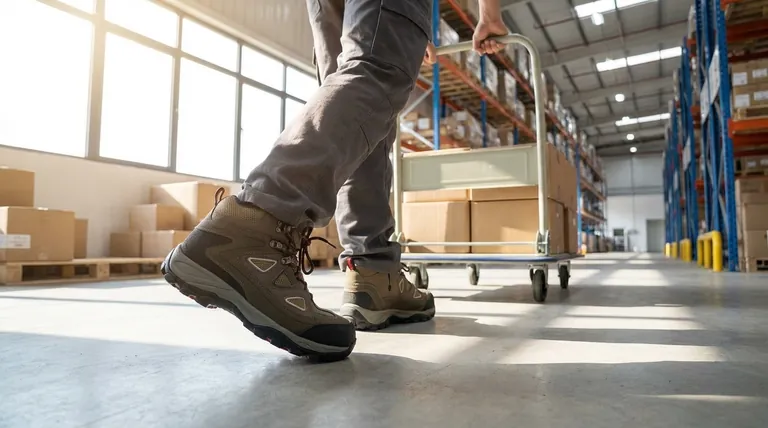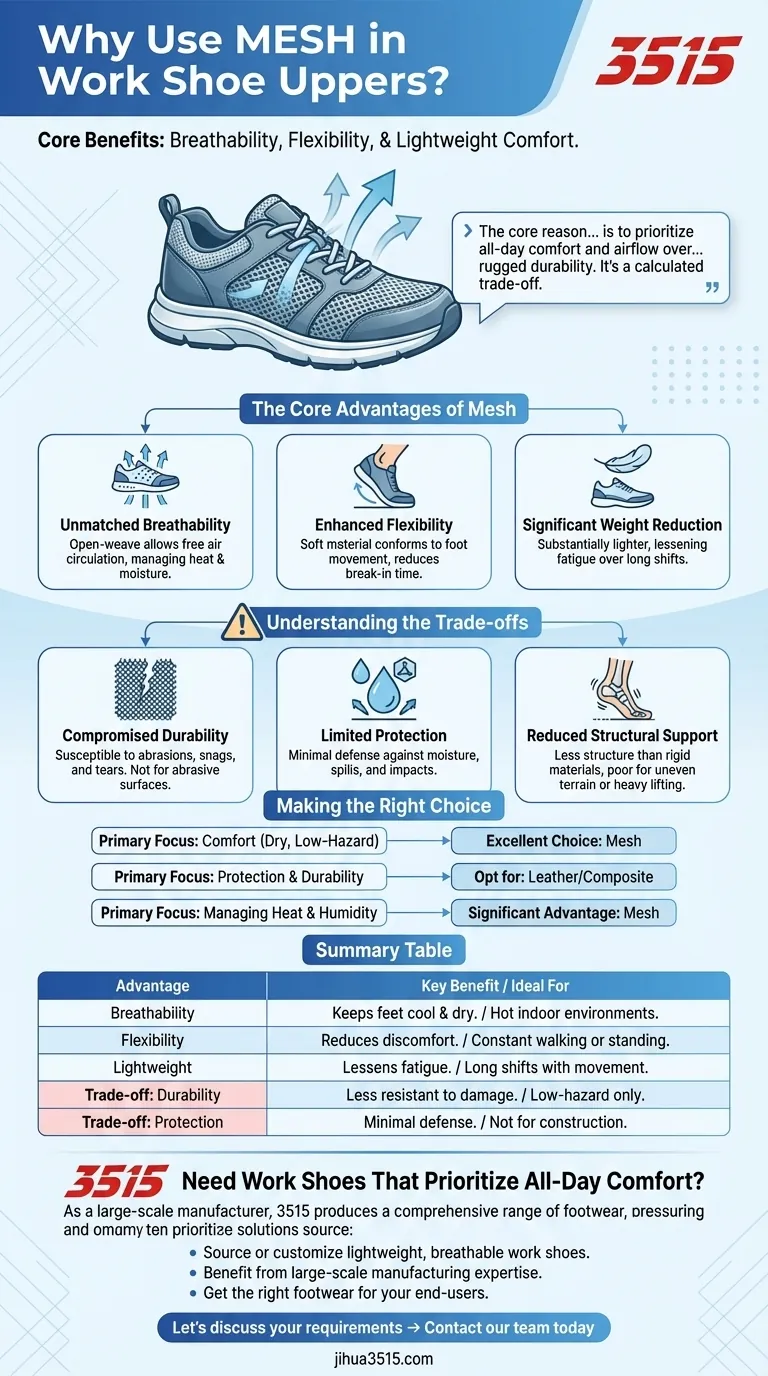In short, mesh is used in work shoe uppers primarily for its exceptional breathability, flexibility, and lightweight properties. These characteristics combine to create a significantly more comfortable experience for the wearer, especially during long shifts in warm or indoor environments.
The core reason for choosing a mesh work shoe is to prioritize all-day comfort and airflow over the rugged durability and protection offered by traditional materials like leather. It's a calculated trade-off based on the specific demands of the work environment.

The Core Advantages of Mesh Uppers
When a job requires constant movement without exposure to heavy hazards, the material of your shoe upper becomes a critical factor in daily comfort and reducing fatigue. Mesh offers distinct advantages in these scenarios.
Unmatched Breathability
The open-weave construction of mesh allows air to circulate freely around the foot. This ventilation is crucial for managing heat and moisture, keeping feet cooler and drier, particularly in hot or humid conditions.
Enhanced Flexibility
Unlike rigid leather, mesh is soft and conforms to the natural movement of your foot. This flexibility reduces break-in time and can prevent irritation or discomfort for those who spend all day walking or standing.
Significant Weight Reduction
Mesh is substantially lighter than leather or other robust synthetic materials. Shaving ounces off each shoe may seem minor, but over thousands of steps in a workday, this weight reduction significantly lessens fatigue in the feet and legs.
Understanding the Trade-offs
While mesh excels in comfort, it is not a universal solution. Its benefits come with clear and important limitations that must be considered for safety and longevity.
Compromised Durability
Mesh uppers are far more susceptible to abrasions, snags, and tears than leather or reinforced synthetics. They are not built to withstand rough contact with abrasive surfaces or sharp objects.
Limited Protection
Mesh offers minimal defense against workplace hazards. It provides virtually no protection from moisture like rain or spills, and it cannot shield the foot from chemical splashes or impacts from falling objects.
Reduced Structural Support
For jobs that require strong ankle and foot support, mesh is a poor choice. The inherent flexibility means it provides less structure than a rigid leather or suede upper, which can be critical on uneven terrain or when lifting heavy loads.
Making the Right Choice for Your Work Environment
Selecting the right upper material is about matching the shoe's features to your specific job risks and daily tasks.
- If your primary focus is comfort in a dry, low-hazard environment: Mesh is an excellent choice for roles in warehousing, logistics, light manufacturing, or any job that requires extensive walking indoors.
- If your primary focus is protection and durability: You must opt for leather or composite uppers for work in construction, heavy industry, or any environment with moisture, chemical, or impact risks.
- If your primary focus is managing heat and humidity: Mesh provides a significant advantage over any other material in keeping your feet cool and mitigating sweat.
Ultimately, choosing a work shoe with a mesh upper is a deliberate decision to optimize for a light, airy, and comfortable experience in a safe environment.
Summary Table:
| Advantage | Key Benefit | Ideal For |
|---|---|---|
| Breathability | Allows air to circulate, keeping feet cool and dry. | Hot or humid indoor environments. |
| Flexibility | Conforms to foot movement, reducing break-in time and discomfort. | Jobs requiring constant walking or standing. |
| Lightweight | Reduces overall shoe weight, lessening leg and foot fatigue. | Long shifts with extensive movement. |
| Trade-off: Durability | Less resistant to abrasions and tears than leather. | Low-hazard, dry work environments only. |
| Trade-off: Protection | Offers minimal defense against moisture, chemicals, or impacts. | Not suitable for construction or heavy industry. |
Need Work Shoes That Prioritize All-Day Comfort?
As a large-scale manufacturer, 3515 produces a comprehensive range of footwear for distributors, brand owners, and bulk clients. Our production capabilities encompass all types of shoes and boots, including specialized lines with breathable mesh uppers designed for comfort in low-hazard environments.
We can help you:
- Source or customize lightweight, breathable work shoes for your specific market needs.
- Benefit from our large-scale manufacturing expertise to ensure consistent quality and competitive pricing.
- Get the right footwear that matches the exact demands of your end-users' work environments.
Let's discuss your requirements → Contact our team today to get started.
Visual Guide

Related Products
- Safety Footwear Wholesale Manufacturer for Custom OEM/ODM Production
- Premium KPU Injection Athletic Style Safety Shoes
- Wholesale Safety Footwear Manufacturer for Bulk & Custom OEM Orders
- High Performance Fire-Retardant Waterproof Safety Boots
- Premium High-Cut Waterproof Safety Boots Manufacturing & Wholesale Solutions
People Also Ask
- What are the cultural perspectives on wearing shoes in the house? A Guide to Home Etiquette & Hygiene
- How long can you wear safety boots? The Lifespan is Determined by Wear, Not Time
- Do snake bite boots work? Your Ultimate Guide to Effective Snake Bite Protection
- Is it normal to wear shoes in the house? A Guide to Hygiene, Comfort & Culture
- What do heavy duty boots do? Protect Your Feet in Demanding Work Environments



















